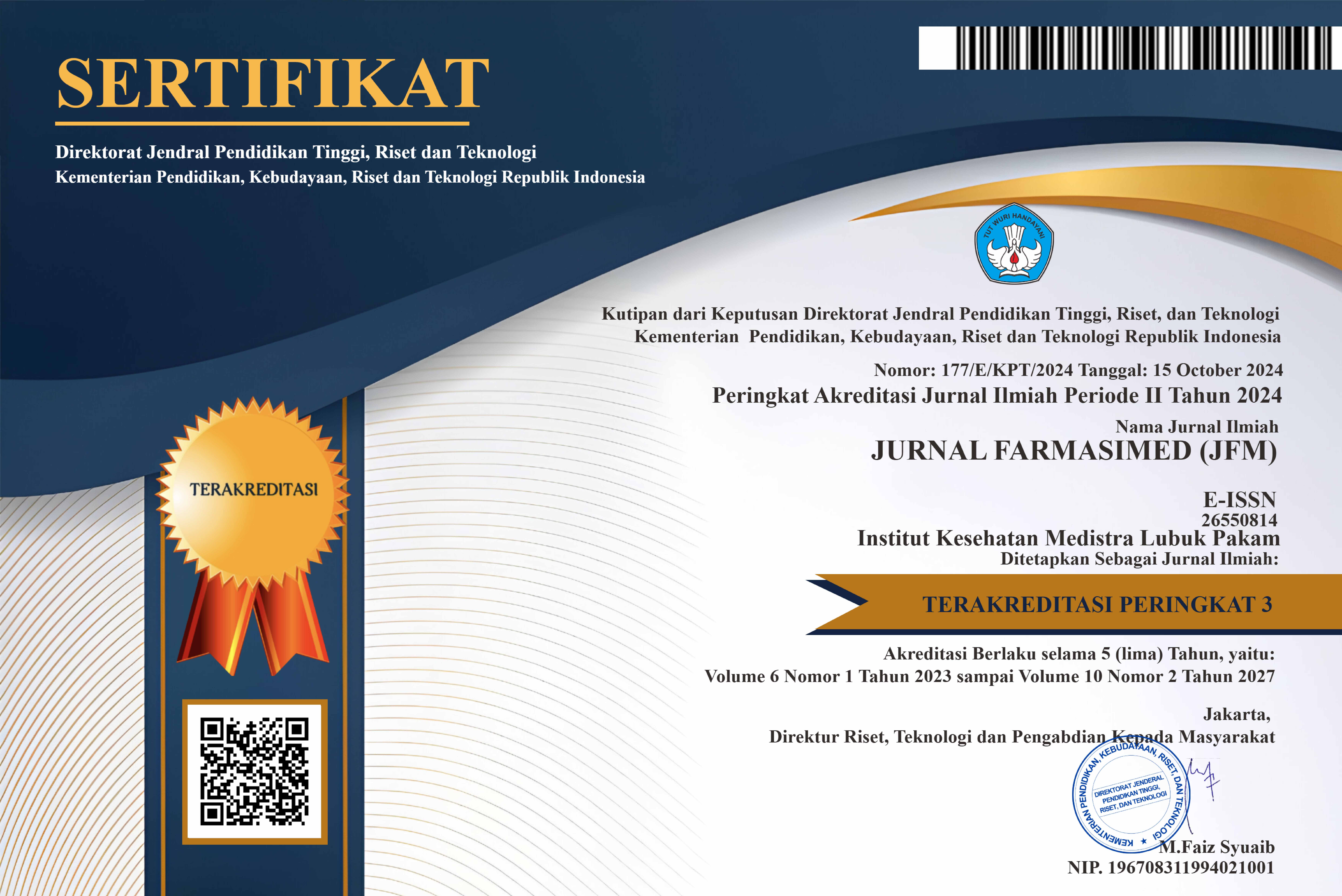TEST OF EFFECT KEDONDONG LEAF ETHANOL EXTRACT (SPONDIAS DULCIS) ON STAPHYLOCOCCUS AUREUS BACTERIA
DOI:
https://doi.org/10.35451/jfm.v5i2.1541Keywords:
Anti-bacterial, Staphylococcus aureus , kedondong leavesAbstract
Bacteria that cause infection and disease are commonly found in our environment, one of which is Staphylococcus aureus bacteria. Several infectious diseases are also caused by Staphylococcus aureus, including cellulitis, acne (acne), and infection with Staphylococcal Scalded Skin Syndrome (SSSS). To determine whether the ethanol extract of kedondong leaves (EEDK) has antibacterial activity against Staphylococcus aureus bacteria. This study used a laboratory experimental method with several stages such as sample collection, identification of plants for making simplicia, phytochemical screening, extract preparation and preparation of kedondong leaf extract test solutions with various concentrations of 15%, 25%, 35% and positive control (Chloramphenicol), negative control (DMSO), and antibacterial activity testing using the paper disc method. The results of phytochemical screening of kedondong leaf simplicia (Spondias dulcis) found that kedondong leaves contain secondary metabolites such as alkaloids, flavonoids, tannins and saponins that have the potential to inhibit bacterial growth. % of 9.4 mm, 25% concentration of 13.5 mm and the greatest inhibition was at a concentration of 35% of 19.5 mm. Kedondong leaf extract has antibacterial activity against the growth of Staphylococcus aureus bacteria, with moderate to strong categories. inhibit the activity of Staphylococcus aureus bacteria is a concentration of 35%. Based on the description above, it was found that the EED with a concentration of 35% had the greatest antibacterial effect compared to the concentration of 15% and 25%. and it can be concluded that the higher the concentration of the extract used, the higher the antibacterial effect.
Downloads
References
Arfani, Nurfitri. (2021). Identification of Staphylococcus aereus Bacteria on the Skin. Bantul – Jogyakarta: Indonesian KBM Publisher.
Anggriani, F & Muhammad S. (2021). Test of the inhibition of kedondong leaf extract (Spondias dulcis) on the growth of Escherichia coli ATCC 35218. Vol.IV Number 1.
Binugraheni, R., & Larasati, N. (2020). Antibacterial activity test of kocombrang leaves (Nicolaia. Journal of Health, 7(2), 51-58.
Kusumawati, E., Supriningrum, R., & Rozadi, R. (2017). Antibacterial Activity Test of Ethanol Extract of Kecombrang Etlingera elatior (Jack) Rm Sm on Salmonella Thphi. Manuntung Scientific Journal, 1 (1), 1-7.
Meshram, GG. et al. (2018). Staphylococcal scalded skin syndrome : A pediatric dermatology case report. SAGE Open medical case reports, G, P, 2050313X17750890
Mustika, N. (2018). Preparation of nanoparticles from the ethanol extract of pugun tanoh leaves (Picria fel – terrae Lour) and Antibacterial tests against Staphylococcus aureus and Escherichia coli. Faculty of Pharmacy, University of North Sumatra, Medan.
Retnaningsih, A., Primadiamanti, A., & Fabrianti, A. (2019). Test of the Inhibitory Power of Purple Leaf Ethanol Extract (Graptophyllum pictum (L.). JOURNAL OF PHARMACEUTICAL ANALYSIS, 4(1), 1-9.
Rosmania, & Yanti, f. (2020). Calculation of the Number of Bacteria in the Microbiology Laboratory. Journal of Science Research, 22(2), 76-86.
Surya, A & Sumijan. (2021). The expert system uses the case based reasoning method in the accuracy of diseases caused by Staphylococcus aureus bacteria. Journal of information systems and technology. Vol. 3. No. 1. 13 – 19
Downloads
Published
Issue
Section
License
Copyright (c) 2023 Novidawati Boru Situmorang, Nurdilla Fatima, Romauli Anna Teresia Marbun, Yanna Rotua Sihombing

This work is licensed under a Creative Commons Attribution-NonCommercial-ShareAlike 4.0 International License.
Copyright in each article is the property of the Author.

























